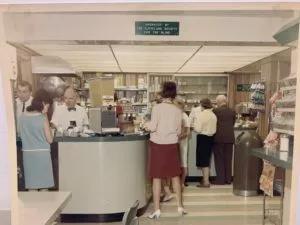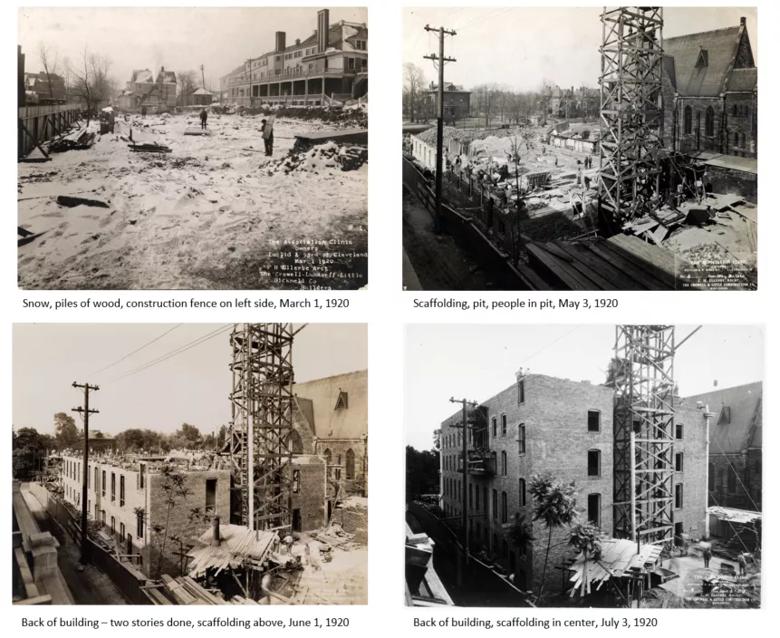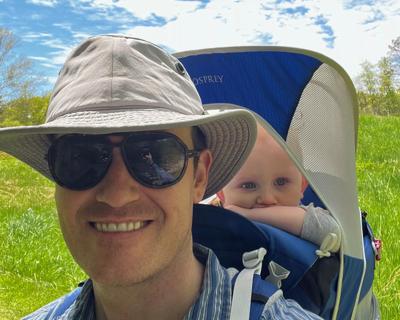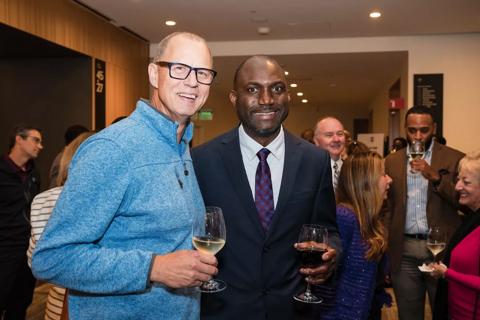Alumni Connection’s FROM THE ARCHIVES series highlights important or interesting moments in Cleveland Clinic’s history

Building, no windows, construction fence, scaffolding from upper to second story window, Aug 5, 1920
Advertisement
Cleveland Clinic is a non-profit academic medical center. Advertising on our site helps support our mission. We do not endorse non-Cleveland Clinic products or services. Policy
Dr. Leonard Calabrese, Chair, History Project
Cleveland Clinic’s original building that opened in 1921 was beautiful. It had unique features, like an open and airy space with a skylight, which gave it more of a feeling of a hotel or theater lobby than a hospital setting. The second and third floors were wraparound corridors, where a physician could take a patient out the door on one side and walk around to personally introduce the patient to another physician on the other side. It was very intimate.
However, the story of the original building is forever and inextricably linked to the Cleveland Clinic Disaster of 1929. There was a lot of internal debate at the time as to what to do with the building and whether it should be razed. Dr. Crile thought that they would be able to reuse it, but it was decided that it should look different. Indeed, it is not recognizable in its present form when compared to its appearance on opening day, Feb. 21, 1921. Some of us feel that the structure known as the T building is a very hallowed part of the campus, and it certainly is an important part of Cleveland Clinic’s story.

Snack shop photos courtesy of Cleveland Sight Center
Since the Disaster, this building has undergone varying iterations – patient care, research, administrative offices. One of the really unusual features that I recall was a snack bar in the lobby run by blind volunteers, a collaboration between Cleveland Clinic and the Cleveland Sight Center. I remember going there as a small child when I had a doctor’s appointment, and it was still a place where I could go for lunch when I was a medical student.
Advertisement
As our Archives article Building Cleveland Clinic notes below, Cleveland Clinic is like a family for those who work here. And, as the article also states, this is literally true for those whose children have followed in their footsteps. I am proud to say that my daughter, Cassandra Calabrese, DO, and I did all of our training at Cleveland Clinic and also were both chief residents in medicine – the only father-child pair to do so. Today, we work in the same department and collaborate on most of our research projects. The article mentions that Robert Eaton LeFevre trained at Cleveland Clinic and became a physician here, like his father, Fay LeFevre. George Crile and Barney Crile both practiced at Cleveland Clinic, too. Also, Alexander T. Bunts, Frank Bunts’ son, looms large in Cleveland Clinic’s history. Our sense of family at Cleveland Clinic, both metaphorical and literal, has contributed to our success since our founding in 1921 and our recovery from the tragedy of 1929. It is an important aspect of who we are and who we will become.
Cleveland Clinic Archives
When the four Founders of Cleveland Clinic – Drs. George Crile, Frank Bunts, William Lower, and John Phillips – decided to establish a group practice, their first step was to find a place for it. In October 1919, with the help of lawyer Edward Daoust, they organized the Association Building Company. This company raised money by selling common and preferred stock, mostly to the founders, their families, and friends. With funds acquired, the founders signed a 99-year (or “perpetual”) lease for the parcel at the corner of Euclid and East 93rd Street. They hired architects Ellerbe & Co. of St. Paul to design the new building.
Advertisement
Photos now held in the Cleveland Clinic Archives document the progress of construction, which began in February 1920. Taken monthly, these photos show the building’s transformation from a snow-covered foundation to a scaffold-covered frame to, finally, a complete new clinic. The founders held a flag-raising ceremony on July 3, 1920. Finally, the new Cleveland Clinic opened on February 21, 1921, marked with a ceremony featuring speeches, music and tours.

The new 41,000-square-foot building had four stories, the upper three centered around a large atrium that functioned as the waiting room. The exterior was of mottled white brick, and the rooms inside were finished light gray with birch woodwork. The first floor housed the X-ray department, clinical labs, and pharmacy. The fourth floor was home to the art and photography department, editorial offices, library, boardroom, administrative offices, and biophysics lab. On the second and third floors, offices, examining rooms, and treatment rooms opened onto the waiting room or corridors of balconies surrounding the atrium.
After the Cleveland Clinic Disaster of 1929, the Executive Committee resolved to remodel the building as soon as it was proven to be safe. The Research Department conducted extensive tests to ensure that no poisonous gas remained in the building. Cleveland Clinic again hired Ellerbe & Co. to design the remodel. The Board agreed that converting the building to administrative offices only would best allow it to remain in use while protecting any patients from discomfort associated with memories of the disaster. The remodel – and concurrent construction of a new, larger Clinic building on East. 93rd Street – proceeded throughout 1930. Both buildings opened in 1931.
Advertisement
Over the years, the original four-story building has remained part of Cleveland Clinic, housing many different departments and offices. Now known as the T building, it stands as a connection to Cleveland Clinic’s heritage and legacy of overcoming adversity.
In the Archives, we often hear staff members observe that Cleveland Clinic “is like a family.” For some alumni, that’s literally true: Members of the same family, spread across generations and medical specialties, have shared the Cleveland Clinic experience.
The LeFevres are one such family. Fay LeFevre, MD, followed his father’s footsteps to become a physician. At Cleveland Clinic, Dr. LeFevre founded the Department of Peripheral Vascular Disease and led the institution into a new era as the first chair of the newly formed Board of Governors. In turn his own son, Robert Eaton LeFevre, also became a physician and trained at Cleveland Clinic in surgery and urology.


Alumni Connection’s FROM THE ARCHIVES series highlights important or interesting moments in Cleveland Clinic’s history, serving as a retrospective of the institution’s storied past as its 100th anniversary approaches in 2021. You are invited to submit topics for us to consider. Please contact Mindy Stroh, Senior Director, Alumni Relations, at strohm@ccf.org.
Advertisement
Advertisement

Honoring Exceptional Achievement, Service and Leadership

We celebrate the exceptional achievements of four future alumni

Honoring Exceptional Achievement and Leadership

Meet Hardeep Phull, MD (CCLCM’11)

Meet William Tierney, MD, MS (CCLCM’16, OTO’18)

Meet Samuel Omotoye, MD (CARD/E'15)